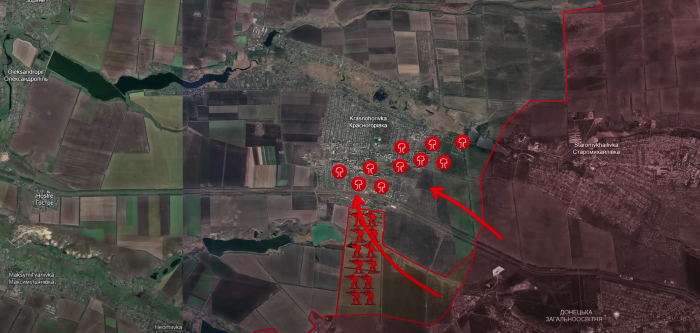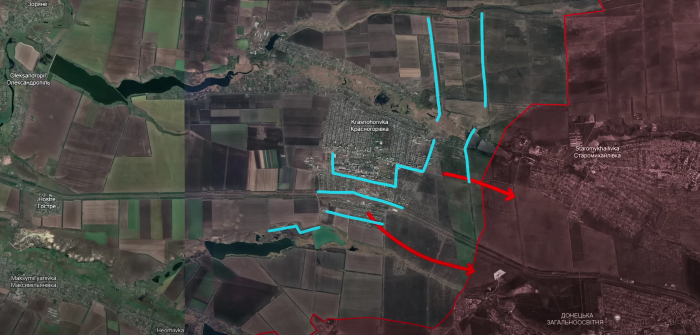Frontline report: Russian forces double down on Krasnohorivka offensive
In a massive escalation around the strategic town of Krasnohorivka, Russian troops have launched a multi-pronged assault involving dozens of armored vehicles, devastating FAB-1500 glide bombs, and up to six attack helicopters, according to a Ukrainian officer.


Day 792: 25 April
On 25 April, there are a lot of developments in the Kurakhove direction.
In the last few days, there have been a series of attacks and counterattacks around Krasnohorivka, which have increased in intensity and signaled Russian forces’ high priority to establish control of this town as a preliminary step to launching an attack on Kurakhove.

After the fall of Marinka, Krasnohorivka became the next logical step due to its high tactical value for the Russians. Taking the town would allow them to push into the fields, compromising the supply to the Ukrainian fortress settlements further along the line behind Marinka and providing fire control into the Ukrainian flanks. This way, the Russians would gain a significant advantage by attacking the Ukrainians from the flanks.

Russian attacks over Krasnohorivka, which have been ongoing for weeks, are conducted on two main vectors: from the south towards the residential district and from the east, through the farms and field lands. The Russians faced heavy resistance in both vectors because these areas had already been fortified since the initial conflict in 2014.
As a result, Russian assaults on the city’s southern district and from the east through the farms and countryside areas ultimately failed in their first attempt because Russian forces could not consolidate their positions, forcing them to retreat. However, it took only a short time for Russian forces to regroup and begin preparations for the next assault. These efforts included significant artillery preparation.

Among other objectives, geolocated footage confirmed the destruction of Ukrainian electronic warfare equipment, which was in the process of being deployed.
Shortly after that, the Russians finally launched their next wave, attacking from both the east and south vectors. In this last vector, the mechanized assault was remarkable, consisting of about two platoons. The geolocated footage shows a first advance with six armored vehicles, which got under heavy artillery fire already on the approach.
Ukrainians extensively used cluster munition, and the mechanized attack was finally repelled with the help of FPV drones. What happened next has been the subject of worldwide attention: the Russians led the next mechanized wave with a wholly welded metal plates-covered tank intended as protection against FPV drones.
In addition, a strong electronic warfare device was placed at the upper part to undermine FPV attacks. This interesting assembly, nicknamed “turtle tank,” was, in fact, able to advance through the southern district and return to its base without being destroyed.
This event prompted remarks from several Ukrainian military analysts for two reasons. Firstly, no FPV drone attacks over the turtle tank were reported, so electronic warfare devices on board proved to be effective. Secondly, ATGM units did not attack the tank either, and only artillery fire was reported, indicating a worrying material shortage in this front area.
As for the turtle tank, after countless comments on social media, Russian forces finally published a more detailed video where they illustrated the development process of the turtle tank, showing further details. Ukrainian forces geolocated this footage, and shortly after that, the turtle tank base was hit and destroyed by a Ukrainian HIMARS attack.
Up next, it was the turn of the Ukrainians. Geolocated images show Ukrainian forces’ counterattack in the same areas as the earlier Russian attack, indicating that Ukrainian troops regained their positions following the initial Russian mechanized assault. The videos show several shell and FPV drone attacks over a building in the eastern part of the city. This building was one of the main Russian positions in the area. In the end, the upper floor of the building started to burn, and some parts even began to collapse. The Russians found it difficult to accept this setback, and as if the scale of the last attack was not big enough, Russian forces doubled down on their effort and increased the scale of their next offensive to a massive level.

Firstly, Russian forces relaunched the turtle tank concept with new iterations, with the same tactical idea of leading several waves of mechanized attacks. A Ukrainian officer stated that Russian forces conducted mechanized assaults near Krasnohorivka using dozens of armored vehicles, including BMPs and T-72 tanks. The Ukrainian officer stated that the Ukrainian troops destroyed only a part of the Russian armored vehicles, thus indicating that at least a part of them could indeed deploy infantry inside the city.
Secondly, Russian forces displayed a comprehensive display of devastating means. The Russians went all out with a massive bombardment, employing Tuplip heavy mortar equipment and FAB 1500 glide bombs. Some military analysts commented on this, indicating FAB glide bombs are crucial in opening the way to Russian forces.
As a culmination of this extensive deployment, up to six Russian attack helicopters were reportedly deployed to the attack. Geolocated footage shows a hail of missiles against various Ukrainian positions. However, the Ukrainian positions in the industrial zone are heavily fortified, and so far, Ukrainians have been able to withstand these intense attacks.
The situation for the Ukrainians remains complicated, and Russian forces consolidated in Krasnohorivka outskirts. However, they seem to be in a phase of concentration of troops and do not appear to have initiated the main assault. A tough urban battle has just begun, and the FAB glide bombs are playing an important role in opening the way for the Russians to advance over the city faster than in previous battles.
Russian forces are trying to increase the pace and take advantage of the narrow window of opportunity in anticipation of the imminent arrival of Western assistance following the recent approval of the aid package by the US Senate after several months of deadlock.
However, Russian advances will slow down as soon as they come close to the industrial zone, which is full of places where Ukrainian soldiers can defend and hold their positions much more easily.
In our daily frontline report, we pair up with the military blogger Reporting from Ukraine to keep you informed about what is happening on the battlefield in the Russo-Ukrainian war.
Read also:
You could close this page. Or you could join our community and help us produce more materials like this.
We keep our reporting open and accessible to everyone because we believe in the power of free information. This is why our small, cost-effective team depends on the support of readers like you to bring deliver timely news, quality analysis, and on-the-ground reports about Russia's war against Ukraine and Ukraine's struggle to build a democratic society.
A little bit goes a long way: for as little as the cost of one cup of coffee a month, you can help build bridges between Ukraine and the rest of the world, plus become a co-creator and vote for topics we should cover next. Become a patron or see other ways to support.



